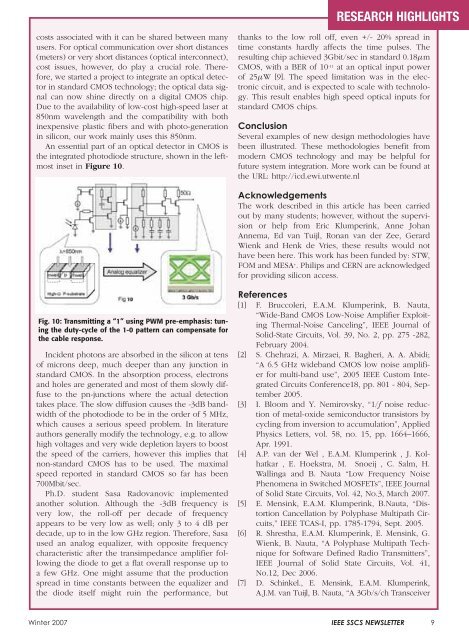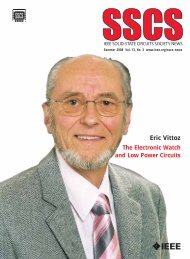The Impact of Dennard's Scaling Theory - IEEE
The Impact of Dennard's Scaling Theory - IEEE
The Impact of Dennard's Scaling Theory - IEEE
- TAGS
- scaling
- www.ieee.org
You also want an ePaper? Increase the reach of your titles
YUMPU automatically turns print PDFs into web optimized ePapers that Google loves.
costs associated with it can be shared between many<br />
users. For optical communication over short distances<br />
(meters) or very short distances (optical interconnect),<br />
cost issues, however, do play a crucial role. <strong>The</strong>refore,<br />
we started a project to integrate an optical detector<br />
in standard CMOS technology; the optical data signal<br />
can now shine directly on a digital CMOS chip.<br />
Due to the availability <strong>of</strong> low-cost high-speed laser at<br />
850nm wavelength and the compatibility with both<br />
inexpensive plastic fibers and with photo-generation<br />
in silicon, our work mainly uses this 850nm.<br />
An essential part <strong>of</strong> an optical detector in CMOS is<br />
the integrated photodiode structure, shown in the leftmost<br />
inset in Figure 10.<br />
Fig. 10: Transmitting a “1” using PWM pre-emphasis: tuning<br />
the duty-cycle <strong>of</strong> the 1-0 pattern can compensate for<br />
the cable response.<br />
Incident photons are absorbed in the silicon at tens<br />
<strong>of</strong> microns deep, much deeper than any junction in<br />
standard CMOS. In the absorption process, electrons<br />
and holes are generated and most <strong>of</strong> them slowly diffuse<br />
to the pn-junctions where the actual detection<br />
takes place. <strong>The</strong> slow diffusion causes the -3dB bandwidth<br />
<strong>of</strong> the photodiode to be in the order <strong>of</strong> 5 MHz,<br />
which causes a serious speed problem. In literature<br />
authors generally modify the technology, e.g. to allow<br />
high voltages and very wide depletion layers to boost<br />
the speed <strong>of</strong> the carriers, however this implies that<br />
non-standard CMOS has to be used. <strong>The</strong> maximal<br />
speed reported in standard CMOS so far has been<br />
700Mbit/sec.<br />
Ph.D. student Sasa Radovanovic implemented<br />
another solution. Although the -3dB frequency is<br />
very low, the roll-<strong>of</strong>f per decade <strong>of</strong> frequency<br />
appears to be very low as well; only 3 to 4 dB per<br />
decade, up to in the low GHz region. <strong>The</strong>refore, Sasa<br />
used an analog equalizer, with opposite frequency<br />
characteristic after the transimpedance amplifier following<br />
the diode to get a flat overall response up to<br />
a few GHz. One might assume that the production<br />
spread in time constants between the equalizer and<br />
the diode itself might ruin the performance, but<br />
RESEARCH HIGHLIGHTS<br />
thanks to the low roll <strong>of</strong>f, even +/- 20% spread in<br />
time constants hardly affects the time pulses. <strong>The</strong><br />
resulting chip achieved 3Gbit/sec in standard 0.18μm<br />
CMOS, with a BER <strong>of</strong> 10 -11 at an optical input power<br />
<strong>of</strong> 25μW [9]. <strong>The</strong> speed limitation was in the electronic<br />
circuit, and is expected to scale with technology.<br />
This result enables high speed optical inputs for<br />
standard CMOS chips.<br />
Conclusion<br />
Several examples <strong>of</strong> new design methodologies have<br />
been illustrated. <strong>The</strong>se methodologies benefit from<br />
modern CMOS technology and may be helpful for<br />
future system integration. More work can be found at<br />
the URL: http://icd.ewi.utwente.nl<br />
Acknowledgements<br />
<strong>The</strong> work described in this article has been carried<br />
out by many students; however, without the supervision<br />
or help from Eric Klumperink, Anne Johan<br />
Annema, Ed van Tuijl, Ronan van der Zee, Gerard<br />
Wienk and Henk de Vries, these results would not<br />
have been here. This work has been funded by: STW,<br />
FOM and MESA +. Philips and CERN are acknowledged<br />
for providing silicon access.<br />
References<br />
[1] F. Bruccoleri, E.A.M. Klumperink, B. Nauta,<br />
“Wide-Band CMOS Low-Noise Amplifier Exploiting<br />
<strong>The</strong>rmal-Noise Canceling”, <strong>IEEE</strong> Journal <strong>of</strong><br />
Solid-State Circuits, Vol. 39, No. 2, pp. 275 -282,<br />
February 2004.<br />
[2] S. Chehrazi, A. Mirzaei, R. Bagheri, A. A. Abidi;<br />
“A 6.5 GHz wideband CMOS low noise amplifier<br />
for multi-band use”, 2005 <strong>IEEE</strong> Custom Integrated<br />
Circuits Conference18, pp. 801 - 804, September<br />
2005.<br />
[3] I. Bloom and Y. Nemirovsky, “1/f noise reduction<br />
<strong>of</strong> metal-oxide semiconductor transistors by<br />
cycling from inversion to accumulation”, Applied<br />
Physics Letters, vol. 58, no. 15, pp. 1664–1666,<br />
Apr. 1991.<br />
[4] A.P. van der Wel , E.A.M. Klumperink , J. Kolhatkar<br />
, E. Hoekstra, M. Snoeij , C. Salm, H.<br />
Wallinga and B. Nauta “Low Frequency Noise<br />
Phenomena in Switched MOSFETs”, <strong>IEEE</strong> Journal<br />
<strong>of</strong> Solid State Circuits, Vol. 42, No.3, March 2007.<br />
[5] E. Mensink, E.A.M. Klumperink, B.Nauta, “Distortion<br />
Cancellation by Polyphase Multipath Circuits,”<br />
<strong>IEEE</strong> TCAS-I, pp. 1785-1794, Sept. 2005.<br />
[6] R. Shrestha, E.A.M. Klumperink, E. Mensink, G.<br />
Wienk, B. Nauta, “A Polyphase Multipath Technique<br />
for S<strong>of</strong>tware Defined Radio Transmitters”,<br />
<strong>IEEE</strong> Journal <strong>of</strong> Solid State Circuits, Vol. 41,<br />
No.12, Dec 2006.<br />
[7] D. Schinkel., E. Mensink, E.A.M. Klumperink,<br />
A.J.M. van Tuijl, B. Nauta, “A 3Gb/s/ch Transceiver<br />
Winter 2007 <strong>IEEE</strong> SSCS NEWSLETTER 9




